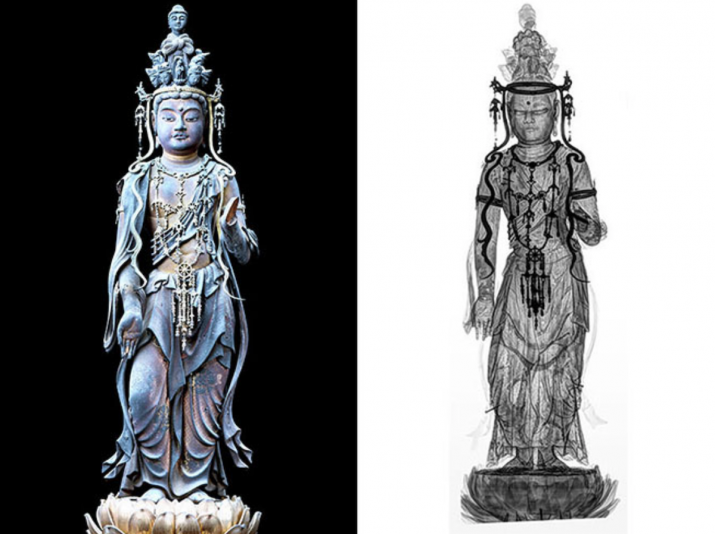
Art historians in Japan have identified a statue of Kannon (観音; Skt: Avalokiteshvara; Ch: Guanyin) the bodhisattva of compassion and mercy, housed at Takisan-ji, a seventh-century Buddhist temple in Japan’s Aichi Prefecture, as most likely being the work of the acclaimed Kamakura period (1185–1333) sculptor Kaikei.
The 50-centimeter sculpture of a standing 11-faced Kannon Bodhisattva, which is carved from wood, decorated with gold leaf, and mounted on a pedestal, is notably similar to other works attributed to the acclaimed artist, Atsushi Aoki, professor of Japanese art history at Tama Art University in Tokyo, told The Asahi Shimbun newspaper on 20 May.
The bodhisattva Avalokiteshvara embodies the compassion of all buddhas and is venerated in almost all Buddhist traditions. Some representations of Avalokiteshvara are depicted with 11 heads or faces to better bear witness to the multitude of suffering of all sentient beings.
Prof. Aoki examined the Kannon statue during a two-year study of some 20 sculptures in Japan that are believed to be extant works by Kaikei. The investigation, which included X-ray scans of the statue, uncovered a recess at the back of the statue’s head inside which offerings could be placed—a characteristic similar to other artifacts attributed to Kaikei. X-ray imaging also revealed three eight-centimeter scrolls contained inside the sculpture’s legs, another common feature of Kaikei’s work.
“It was so exciting to peek into the inside of the sculpture. It was like a time capsule,” said Prof. Aoki, noting that the distinguishing characteristics indicated that the statue was most likely created by Kaikei, or possibly a sculptor in his studio. (The Asahi Shimbun)
Kaikei (fl. 1183–1236), a Japanese Busshi or Buddhist sculptor, lived during the tumultuous start of the Kamakura period, when political power in Japan shifted from aristocratic rule in the west (Kyoto, Nara) to the shogunate in Kamakura in the east. The period is also notable for the flourishing of Buddhism across the country—in particular Zen Buddhism and the Jōdo-shū branch of Pure Land Buddhism—and the emergence of the samurai the warrior caste. This politically and socially turbulent period was also a high point in the history of Japanese sculpture, as artists began incorporating stylistic and technical innovations that resulted in a level of realism not previously seen. Sculptors of the era also began signing their work, enabling the evolution of styles by individuals and workshops to be traced and documented. Sculptors in the 18th century could trace their artistic lineages back to early Kamakura masters.
Kaikei was a member of the Kei-ha school, which was founded by his teacher Kokei and became the dominant sculptural school until the 14th century. It specialized in sculpting statues of the Buddha and other important Buddhist figures. The most famous Busshi from the Kei-ha school was Kaikei’s contemporary and Kokei son Unkei. Kaikei’s sculptural style is frequently noted for its realism, grace, and elegance. Kaikei later became a Buddhist monk, taking the Dharma name Anami Butsu. For this reason his sculptural style is known as the Anami style.
Buddhism and Shinto are the two most widespread religious traditions in Japan, with 79.2 per cent of the population identifying as practicing Shinto and 66.8 per cent identifying as Buddhists, indicating a high level of overlap between the two traditions, although, paradoxically, a majority of Japanese also identify as atheists for a number of cultural reasons. Christians represent 1.5 per cent of the population, while other religions make up a combined 7.1 per cent, according to data for 2017. The most popular schools of Buddhism are Nichiren, Pure Land, Shingon, and Zen.
See more
Ancient Kannon statue likely the work of master sculptor Kaikei (The Asahi Shimbun)
滝山寺














